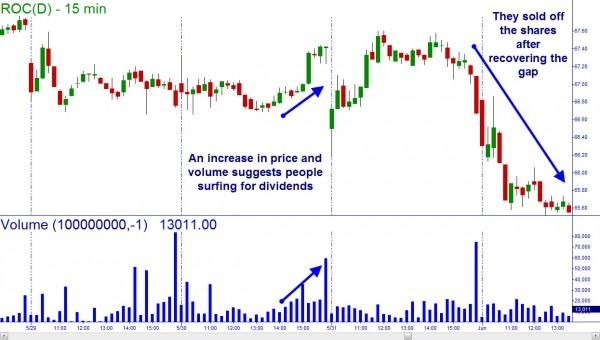Dividend Stripping Is It Worth Playing The Exdiv Calendar
Post on: 28 Июнь, 2015 No Comment

Today, on the subject of dividend strategies. we’re going to look at the idea of arbitraging the dividend calendar. As we’ve discussed elsewhere, a stock is typically valued on the basis of its future cashflows which, in turn, gives rise to an expected future dividend stream (hopefully!).
As a result, when a stock pays out a dividend, one would expect the price of the stock to fall by the amount equal to the dividend since that amount of value has been extracted and is no longer available to new purchasers of the stocks.
However, in reality, practice seems to diverge from this theory (i.e. the stock usually falls by less than this amount ). This has given rise to a possible (somewhat disputed) short-term trading strategy know as dividend stripping or dividend capture discussed below.
Dividend Mechanics
Before getting into that, it’s worth clarifying some basics about exactly how dividend payments work. A company’s Board decides how much each dividend payment will be. Each company will typically have its own dividend policy in which they outline what percentage of the profits will be distributed, but companies are under no obligation to pay a dividend of any set level. Usually, this percentage ranges between 15-50% depending on the strength/maturity of the company and the volatility of its cashflows. This proportion (DPS/EPS) is known as the Payout Ratio in the US — the more commonly discussed measure in the UK is the inverse, called the Dividend Cover (EPS/DPS).
Once the dividend has been declared, it will be paid to every shareholder. In the UK dividends are normally paid semi-annually, after a company’s interim and full-year results (e.g. split one-third at the interim stage and two-thirds at the year-end). However, some larger companies pay out dividends each quarter. The process of paying a dividend has several stages.
1. Announcement/Declaration Date: When a company publishes its results, normally between one and three months after the end of each half-year period, it will declare how much and when its next dividend payment will be. At the time of a dividend declaration is made, the company will typically announce three dates alongside the payment. These are the record date, the payment date and the ex-dividend date, although the phrasing used in the announcement may be different, eg. the dividend . will be paid on [payment date] to shareholders on the register at [record date].
2. Ex-dividend (or ex-div) date. This is the date by which a buyer needs to have bought shares in order to be entitled to a dividend payment. It’s usually a Wednesday. Shares normally trade on the basis of cum (with) dividend so, on the ex-dividend date, the share price will typically fall by roughly the amount of the dividend. If you hold shares in a company and do not realise what’s happening, this drop can be rather disturbing but it does make sense as the company is now effectively worth less for new buyers of shares. We’ll be building the ex-dividend date shortly into all our Stockopedia Premium stock pages but, in the meantime, a list of stocks going ex-dividend can be found here. If a seller has sold the shares prior to the ex-dividend date and has received a dividend, this has been paid in error and a dividend reclaim will be raised to pass the dividend to the correct owner.
3. Record date ( also known as the ‘books closed’ data or the ‘on-register date’): This is the date (usually a couple of days after the ex-dividend date) when the company checks their register to see who is entitled to a dividend. Dividend entitlement however is still based on the ex-dividend date, though. This is often a Friday. On the standard T+3 settlement system operated in the UK (i.e. a trade settles three days after it is executed), investors need to buy a stock three days prior to the record date (that’s to say, the day before the ex-dividend date) to be sure of qualifying for the dividend payment, since three days for settlement is needed before the shareholder’s name goes on the register.
4. Payment date. This is the date that dividend cheques are posted or bank accounts are credited. It typically comes two weeks after the record date but it may even be months after the record date, so it is important to be aware precisely when the payment is likely to be made. Note that if you buy the shares between the ex-dividend date and the payment date then you won’t be entitled to that dividend. In newspapers, this period is often denoted by the letters ‘XD’ next to the share price.
The Ex-Dividend Day Effect
What happens on/around the ex-dividend day has been the subject of quite a lot of academic research because of two surprising phenomena. Firstly, there is often a small but noticeable run-up in the share price of a company just before it goes ex-dividend. This is possibly because of buying interest from investors wanting to hold the shares on the ex-dividend date and thus qualify for the payment. Secondly, when the ex day occurs (when the dividend becomes payable), the share price drops but usually by less than the value of the grossed up dividend.
This anomalyin the price fall is most often attributed to the unfavorable tax treatment of dividends vis a vis capital gains in most markets. A tax advantage available to everyone would be expected to show up in the ex-dividend price fall. But an advantage available only to a limited set of investors might not.
Researchers Elton and Gruber did one of the earliest studies investigating stock price adjustment on ex-dividend dates back in the 1960s. They observed that stock prices drop on average by 77.7% of the dividend paid . They used this ratio to estimate the marginal tax rate at which buyers and sellers would be indifferent between trading ex dividend and cum dividend. Secondly, they noted that the estimated tax rates declined with dividend yield (i.e. stocks with higher yields showed higher adjustment in prices on ex-dividend dates). They interpreted these results as evidence of what they call dividend clienteles — the idea is basically that l ow tax bracket investors like to hold the high yield stocks, whereas high bracket investors prefer the low-yield stocks.
Since then, many studies have been performed in different stock markets (with different tax regimes for dividends and capital gains). Many of these papers support this tax-effect hypothesis, such as Athanassakos (Canada), Hayashi and Jagannathan (Japan), and Poterba and Summers (UK). However, a number of other studies also disagree, preferring alternative explanations like transaction costs and market microstructure effects.
The most pure way of testing the tax-effect hypothesis is by investigating stock price behaviour around ex-dividend days in countries where neither dividends nor capital gains were taxed. Along these lines, Frank and Jagannathan studied the ex-day price behaviour in Hong Kong where this is the case. Again here, prices were found to drop on average by less than the dividend.
Quite why this would be so is unclear. It might be because collecting & reinvesting dividends is administratively more cumbersome than dealing with capital gains. If certain market participants have a comparative cost advantage in collecting and reinvesting dividends (e.g. market-makers), they might buy shares before a stock goes ex-dividend and resell them after the stock goes ex-dividend. Or perhaps naive investors simply forget that there is a dividend payout and plunge more money into the stock at higher prices the next day.
Enough of the theory! I t’s fair to say that the academics aren’t too sure what’s going on. So, the all-important question — is there money to be made here?
Dividend Stripping / Buying ex-Dividend / Dividend Capture

A number of traders advocate a strategy of dividend capture, also known as dividend stripping or ex-dividend trading. This involves buying a stock before the dividend is paid, holding it for a predetermined period (perhaps just overnight), and then selling it and moving on. In essence, dividend capture is about collecting (capturing) the dividend which provides dividend income, and making a capital loss when the shares fall in value (in normal circumstances) on going ex-dividend. This may be profitable if the income is greater than the loss, or if the tax treatment of the two gives an advantage.
Does it work?
It’s hard to say! Just how much money can be made depends on how much the stock bounces back above the ex-dividend price within your defined timeframe. One academic paper titled Taxes, Price Pressure and Order Imbalance around the Ex-Dividend Day focused on the Australian market found that dividend capture yielded positive profits in the 45 day run-up period to the ex-dividend date, as did another Australian study by Kristian Dibble in the Rivkin Report. However, other studies have been far less encouraging, so these results may reflect peculiarities of the Australian tax envionment.
Success with this strategy is likely to turn on being able to select those issues whose stock prices are most buoyant post the fall. For example, stocks with good price momentum often don’t fall as much. However, that sounds more like stock-picking, with all its related risks, rather than a form of easy arbitrage. Hence, dividend capture and ex-dividend strategies are likely to work best in a neutral or rising stock market while, in a falling market, it’s going to be more difficult.
In any case, the amount of profit on each transaction is likely to be small, meaning that it may not still be worthwhile after transaction costs, the risk of holding the shares, or possible slippage if the market lacks liquidity. As Dibble notes:
the variety of individual returns means that an investor will need to do a large number of trades to prudently manage their risk to take advantage of the edge.
Of course, the ex-dividend trading strategy can be enhanced by using margin to purchase the stock. increasing the yield of the dividend received (or by using covered calls), but this kind of investing has its own risks.
Conclusion
We’re unlikely to be modelling this strategy as part of Stockopedia Premium any time soon. Still, as we’ve often said. technical factors usually don’t provide a buy justification, but they can be useful for timing trades. Even if a dividend stripping strategy isn’t worth pursuing — which it probably isn’t — it is still worth being aware that, twice or more a year, a window of opportunity is likely to present itself in order to tax plan and/or manage stock entry and exit decisions. As we’ve discussed, stock prices commonly run up in the cum period, then tends to fall at the ex date. This provides a relatively predictable pattern that is worth bearing in mind when you’re considering a stock sale or purchase for other reasons.














